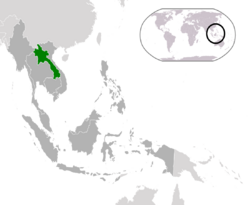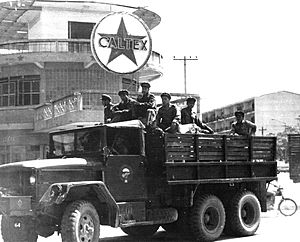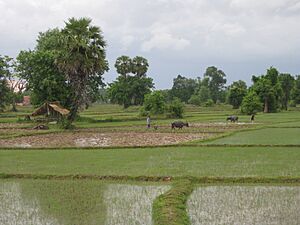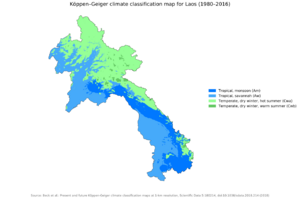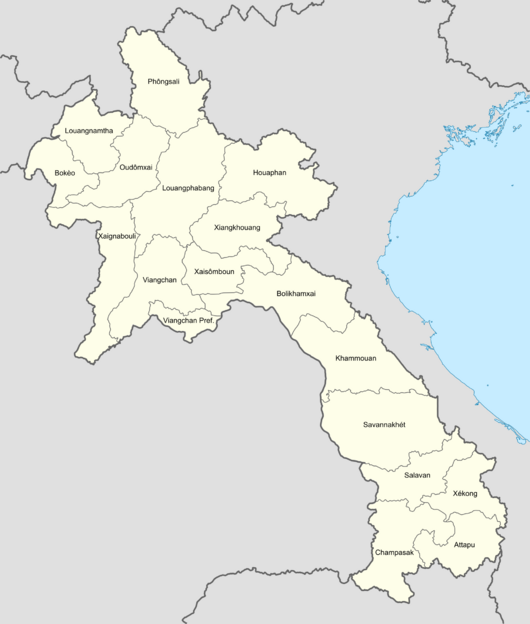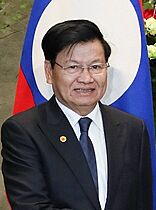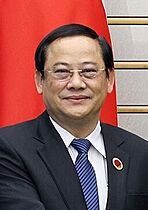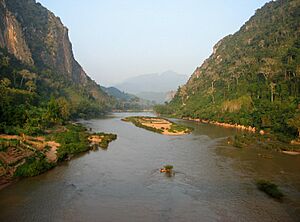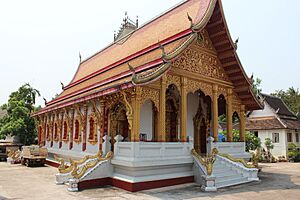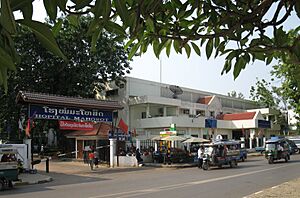Laos facts for kids
Quick facts for kids
Lao People's Democratic Republic
|
|
|---|---|
|
|
|
|
Motto: ສັນຕິພາບ ເອກະລາດ ປະຊາທິປະໄຕ ເອກະພາບ ວັດທະນະຖາວອນ
Santiphap, Ekalat, Paxathipatai, Ekaphap, Vatthanathavon "Peace, Independence, Democracy, Unity and Prosperity" |
|
|
Anthem: ເພງຊາດລາວ
Pheng Xat Lao "Hymn of the Lao People" |
|
| Capital | Vientiane 17°58′N 102°36′E / 17.967°N 102.600°E |
| Official languages | Lao |
| Spoken languages | |
| Ethnic groups
(2015)
|
|
| Religion |
|
| Demonym(s) |
|
| Government | Unitary Marxist–Leninist one-party socialist republic |
| Thongloun Sisoulith | |
| Bounthong Chitmany Pany Yathotou |
|
| Sonexay Siphandone | |
| Legislature | National Assembly |
| Formation | |
| 1353–1707 | |
|
• Kingdoms of Luang Prabang, Vientiane & Champasak
|
1707–1778 |
|
• Vassals of Siam
|
1778–1893 |
|
• French protectorate
|
1893–1953 |
|
• Free Lao Movement
|
1945–1949 |
|
• Unified Kingdom
|
11 May 1947 |
|
• Independence
from France |
22 October 1953 |
|
• Monarchy abolished
|
2 December 1975 |
| Area | |
|
• Total
|
236,800 km2 (91,400 sq mi) (82nd) |
|
• Water (%)
|
2 |
| Population | |
|
• 2022 estimate
|
7,749,595 (103rd) |
|
• Density
|
26.7/km2 (69.2/sq mi) |
| GDP (PPP) | 2023 estimate |
|
• Total
|
|
|
• Per capita
|
|
| GDP (nominal) | 2023 estimate |
|
• Total
|
|
|
• Per capita
|
|
| Gini (2012) | 36.4 medium |
| HDI (2022) | medium · 139th |
| Currency | Kip (₭) (LAK) |
| Time zone | UTC+7 (ICT) |
| Driving side | right |
| Calling code | +856 |
| ISO 3166 code | LA |
| Internet TLD | .la |
Laos, officially the Lao People's Democratic Republic (LPDR), is the only landlocked country in Southeast Asia. It is bordered by Myanmar and China to the northwest, Vietnam to the east, Cambodia to the southeast, and Thailand to the west and southwest. Its capital and most populous city is Vientiane.
Laos traces its historic and cultural identity to Lan Xang, a kingdom which existed from the 13th century to the 18th century. Because of its geographical location, the kingdom became a hub for overland trade. After a period of internal conflict, Lan Xang broke into the Kingdom of Luang Phrabang, the Kingdom of Vientiane and the Kingdom of Champasak. In 1893, the 3 kingdoms were united under a French protectorate. Laos was occupied by Japan during World War II and regained independence in 1945 as a Japanese puppet state and was re-colonised by France, until it won autonomy in 1949. It gained independence in 1953 as the Kingdom of Laos, with a constitutional monarchy under Sisavang Vong. A civil war began in 1959, which saw the communist Pathet Lao, supported by North Vietnam and the Soviet Union, fight against the Royal Lao Armed Forces, supported by the United States. After the Vietnam War ended in 1975, the Lao People's Revolutionary Party established a one-party socialist republic espousing Marxism-Leninism, ending the civil war and monarchy, and beginning a period of alignment with the Soviet Union until the dissolution of the Soviet Union in 1991.
Laos's strategies for development are based on generating electricity from rivers and selling the power to its neighbours, namely Thailand, China and Vietnam, and its initiative to become a "land-linked" nation, as evidenced by the construction of 4 railways connecting Laos and neighbours. Laos has been referred to as 1 of Southeast Asia and Pacific's fastest growing economies by the World Bank with annual GDP growth averaging 7.4% since 2009, while being classified as a least developed country by the United Nations. Laos is a member of the Asia-Pacific Trade Agreement, the ASEAN, East Asia Summit, La Francophonie, and the World Trade Organization.
Etymology
The word Laos was coined by the French, who united the 3 Lao kingdoms in French Indochina in 1893. The name of the country is spelled the same as the plural of the most common ethnic group, the Lao people. In English, the "s" in the name of the country is pronounced, and not silent.
History
Prehistory

A human skull was recovered in 2009 from the Tam Pa Ling Cave in the Annamite Mountains in northern Laos; the skull is at least 46,000 years old, making it the oldest modern human fossil found to date in Southeast Asia. Stone artifacts including Hoabinhian types have been found at sites dating to the Pleistocene in northern Laos. Archaeological evidence suggests an agriculturist society developed during the 4th millennium BC. Burial jars and other kinds of sepulchers suggest a society in which bronze objects appeared around 1500 BC, and iron tools were known from 700 BC. The proto-historic period is characterised by contact with Chinese and Indian civilisations. According to linguistic and other historical evidence, Tai-speaking tribes migrated southwestward to the territories of Laos and Thailand from Guangxi sometime between the 8th and 10th centuries.
Lan Xang
Laos traces its history to the kingdom of Lan Xang ('million elephants'), which was founded in the 13th century by a Lao prince, Fa Ngum, whose father had his family exiled from the Khmer Empire. Fa Ngum, with 10,000 Khmer troops, conquered some Lao principalities in the Mekong river basin, culminating in the capture of Vientiane. Ngum was descended from a line of Lao kings that traced back to Khoun Boulom. He made Theravada Buddhism the state religion. His ministers, unable to tolerate his ruthlessness, forced him into exile to what is later the Thai province of Nan in 1373, where he died. Fa Ngum's eldest son, Oun Heuan, ascended to the throne under the name Samsenethai and reigned for 43 years. Lan Xang became a trade centre during Samsenthai's reign, and after his death in 1421 it collapsed into warring factions for nearly a century.
In 1520, Photisarath came to the throne and moved the capital from Luang Prabang to Vientiane to avoid a Burmese invasion. Setthathirath became king in 1548, after his father was killed, and ordered the construction of That Luang. Settathirath disappeared in the mountains on his way back from a military expedition into Cambodia, and Lan Xang fell into more than 70 years of "instability", involving Burmese invasion and civil war.
In 1637, when Sourigna Vongsa ascended the throne, Lan Xang further expanded its frontiers. When he died without an heir, the kingdom split into 3 principalities. Between 1763 and 1769, Burmese armies overran northern Laos and annexed Luang Prabang, while Champasak eventually came under Siamese suzerainty.
Chao Anouvong was installed as a vassal king of Vientiane by the Siamese. He encouraged a renaissance of Lao fine arts and literature and improved relations with Luang Phrabang. Under Vietnamese pressure, he rebelled against the Siamese in 1826. The rebellion failed, and Vientiane was ransacked. Anouvong was taken to Bangkok as a prisoner, where he died.
In a time period where the acquisition of humans was a priority over the ownership of land, the warfare of pre-modern Southeast Asia revolved around the seizing of people and resources from its enemies. A Siamese military campaign in Laos in 1876 was described by a British observer as having been "transformed into slave-hunting raids on a large scale".
French Laos (1893–1953)
In the 19th century, Luang Prabang was ransacked by the Chinese Black Flag Army. France rescued King Oun Kham and added Luang Phrabang to the protectorate of French Indochina. The Kingdom of Champasak and the territory of Vientiane were added to the protectorate. King Sisavangvong of Luang Phrabang became ruler of a unified Laos, and Vientiane once again became the capital.
Laos produced tin, rubber, and coffee, and never accounted for more than 1% of French Indochina's exports. By 1940, around 600 French citizens lived in Laos. Under French rule, the Vietnamese were encouraged to migrate to Laos, which was seen by the French colonists as a rational solution to a labour shortage within the confines of an Indochina-wide colonial space. By 1943, the Vietnamese population stood at nearly 40,000, forming the majority in some cities of Laos and having the right to elect its own leaders. As a result, 53% of the population of Vientiane, 85% of Thakhek, and 62% of Pakse were Vietnamese, with the exception of Luang Prabang where the population was predominantly Lao. As late as 1945, the French drew up a plan to move a number of Vietnamese to 3 areas, i.e., the Vientiane Plain, Savannakhet region, and the Bolaven Plateau, which was derailed by the Japanese invasion of Indochina. Otherwise, according to Martin Stuart-Fox, the Lao might well have lost control over their own country.
During World War II in Laos, Vichy France, Thailand, Imperial Japan and Free France occupied Laos. On 9 March 1945, a nationalist group declared Laos once more independent, with Luang Prabang as its capital, and on 7 April 1945 2 battalions of Japanese troops occupied the city. The Japanese attempted to force Sisavang Vong (the king of Luang Phrabang) to declare Laotian independence, and on 8 April he instead declared an end to Laos's status as a French protectorate. The king then secretly sent Prince Kindavong to represent Laos to the Allied forces and Prince Sisavang as representative to the Japanese. When Japan surrendered, some Lao nationalists (including Prince Phetsarath) declared Laotian independence, and by 1946, French troops had reoccupied the country and conferred autonomy on Laos.
During the First Indochina War, the Indochinese Communist Party formed the Pathet Lao independence organisation. The Pathet Lao began a war against the French colonial forces with the aid of the Vietnamese independence organisation, the Viet Minh. In 1950, the French were forced to give Laos semi-autonomy as an "associated state" within the French Union. France remained in de facto control until 22 October 1953, when Laos gained full independence as a constitutional monarchy.
Independence and communist rule (1953–present)
The First Indochina War took place across French Indochina and eventually led to French defeat and the signing of a peace accord for Laos at the Geneva Conference of 1954. In 1960, amidst a series of rebellions in the Kingdom of Laos, fighting broke out between the Royal Lao Army (RLA) and the communist North Vietnamese and Soviet Union-backed Pathet Lao guerillas. A second Provisional Government of National Unity formed by Prince Souvanna Phouma in 1962 was unsuccessful, and the situation turned into civil war between the Royal Laotian government and the Pathet Lao. The Pathet Lao were backed militarily by the People's Army of Vietnam (PAVN) and the Viet Cong.
Laos was a part of the Vietnam War since parts of Laos were invaded and occupied by North Vietnam since 1958 for use as a supply route for its war against South Vietnam. In response, the United States initiated a bombing campaign against the PAVN positions, supported regular and irregular anti-communist forces in Laos, and supported incursions into Laos by the Army of the Republic of Vietnam.
Aerial bombardments against the PAVN/Pathet Lao forces were carried out by the United States to prevent the collapse of the Kingdom of Laos central government, and to deny the use of the Ho Chi Minh Trail to attack US forces in South Vietnam. Between 1964 and 1973, the US dropped 2 million tons of bombs on Laos, nearly equal to the 2.1 million tons of bombs the US dropped on Europe and Asia during all of World War II, making Laos the most heavily bombed country in history relative to the size of its population; The New York Times notes this was "nearly a ton for every person in Laos".
Some 80 million bombs failed to explode and remain scattered throughout the country. Unexploded ordnance (UXO), including cluster munitions and mines, kill or maim approximately 50 Laotians every year. Due to the impact of cluster bombs during this war, Laos was an advocate of the Convention on Cluster Munitions to ban the weapons and was host to the First Meeting of States Parties to the convention in November 2010.
In 1975, the Pathet Lao overthrew the royalist government, forcing King Savang Vatthana to abdicate on 2 December 1975. He later died in a re-education camp. Between 20,000 and 62,000 Laotians died during the civil war.
On 2 December 1975, after taking control of the country, the Pathet Lao government under Kaysone Phomvihane renamed the country as the Lao People's Democratic Republic and signed agreements giving Vietnam the right to station armed forces and to appoint advisers to assist in overseeing the country. The ties between Laos and Vietnam were formalised via a treaty signed in 1977, which has since provided direction for Lao foreign policy, and provides the basis for Vietnamese involvement at levels of Lao political and economic life. Laos was requested in 1979 by Vietnam to end relations with the People's Republic of China, leading to isolation in trade by China, the United States, and other countries. In 1979, there were 50,000 PAVN troops stationed in Laos and as many as 6,000 civilian Vietnamese officials including 1,000 directly attached to the ministries in Vientiane.
The conflict between Hmong rebels and Laos continued in areas of Laos, including in Saysaboune Closed Military Zone, Xaisamboune Closed Military Zone near Vientiane Province and Xiangkhouang Province. From 1975 to 1996, the United States resettled some 250,000 Lao refugees from Thailand, including 130,000 Hmong.
On 3 December 2021, the 422-kilometre Boten-Vientiane railway, a flagship of the Belt and Road Initiative (BRI), was opened.
Geography
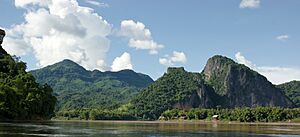
Laos is the only landlocked country in Southeast Asia, and it lies mostly between latitudes 14° and 23°N (an area is south of 14°), and longitudes 100° and 108°E. Its forested landscape consists mostly of mountains, the highest of which is Phou Bia at 2,818 metres (9,245 ft), with some plains and plateaus. The Mekong River forms a part of the western boundary with Thailand, where the mountains of the Annamite Range form most of the eastern border with Vietnam and the Luang Prabang Range the northwestern border with the Thai highlands. There are 2 plateaus, the Xiangkhoang in the north and the Bolaven Plateau at the southern end. Laos can be considered to consist of 3 geographical areas: north, central, and south. Laos had a 2019 Forest Landscape Integrity Index mean score of 5.59/10, ranking it 98th globally out of 172 countries.
Climate
The climate is mostly tropical savanna and influenced by the monsoon pattern. There is a rainy season from May to October, followed by a dry season from November to April. Local tradition holds that there are 3 seasons (rainy, cool and hot) as the latter 2 months of the climatologically defined dry season are hotter than the earlier 4 months.
Wildlife
Administrative divisions
Laos is divided into 17 provinces (khoueng) and one prefecture (kampheng nakhon), which includes the capital city Vientiane (Nakhon Louang Viangchan). A province, Xaisomboun province, was established on 13 December 2013. Provinces are divided into districts (muang) and then villages (ban). An "urban" village is essentially a [town].
|
An updated map of Lao provinces (from 2014) |
|---|
Politics
The Lao PDR is one of the world's socialist states openly endorsing communism. The only legal political party is the Lao People's Revolutionary Party (LPRP). With the one-party state status of Laos, the General Secretary (party leader) holds ultimate power and authority over state and government and serves as the supreme leader.
Laos's first French-written and monarchical constitution was promulgated on 11 May 1947, and declared Laos an independent state within the French Union. The revised constitution of 11 May 1957 omitted reference to the French Union, while educational, health and technical ties with the former colonial power persisted. The 1957 document was abrogated in December 1975, when a communist people's republic was proclaimed. A constitution was adopted in 1991 and enshrined a "leading role" for the LPRP.
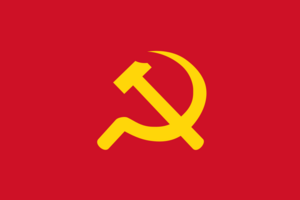
Economy
The Lao economy depends on investment and trade with its neighbours, Thailand, Vietnam, and, especially in the north, China. Pakxe has experienced growth based on cross-border trade with Thailand and Vietnam. In 2009, the Obama administration in the US declared Laos was no longer a Marxist–Leninist state and lifted bans on Laotian companies receiving financing from the US Export-Import Bank.
In 2016, China was the biggest foreign investor in the Laotian economy, having invested US$5.395 billion since 1989, according to the Laos Ministry of Planning and Investment's 1989–2014 report. Thailand (invested US$4.489 billion) and Vietnam (invested US$3.108 billion) are the second and third largest investors respectively.
Subsistence agriculture accounts for half of the GDP and provides 80% of employment. 4% of the country is arable land and 0.3% used as permanent crop land, the lowest percentage in the Greater Mekong Subregion. The irrigated areas account for 28% of the total area under cultivation which, in turn, represents 12% of all of the agricultural land in 2012. Rice dominates agriculture, with about 80% of the arable land area used for growing rice. Approximately 77% of Lao farm households are self-sufficient in rice. Laos may have the greatest number of rice varieties in the Greater Mekong Subregion. The Lao government has been working with the International Rice Research Institute of the Philippines to collect seed samples of each of the thousands of rice varieties found in Laos.
Laos imports petroleum and gas. Metallurgy is an industry, and the government hopes to attract foreign investment to develop the deposits of coal, gold, bauxite, tin, copper, and other metals. The mining industry of Laos has received attention with foreign direct investments. More than 540 mineral deposits of gold, copper, zinc, lead and other minerals have been identified, explored and mined. The country's water resources and mountainous terrain enable it to produce and export quantities of hydroelectric energy. Of the potential capacity of approximately 18,000 megawatts, around 8,000 megawatts have been committed for export to Thailand and Vietnam. As of 2021, Laos continues to rely on fossil fuels, coal in particular, in domestic electricity production.
In 2018, the country ranked 139th on the Human Development Index (HDI), indicating medium development. According to the Global Hunger Index (2018), Laos ranks as the 36th hungriest nation in the world out of the list of the 52 nations with the worst hunger situation(s). In 2019, the UN Special Rapporteur on extreme poverty and human rights conducted an official visit to Laos and found that the country's top-down approach to economic growth and poverty alleviation "is all too often counterproductive, leading to impoverishment and jeopardising the rights of the poor and marginalised."
A product, Beerlao, was exported in 2017 to more than 20 countries worldwide. It is produced by the Lao Brewery Company.
Tourism
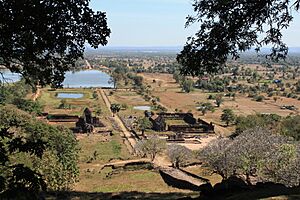
The tourism sector has grown from 80,000 international visitors in 1990, to 1.876 million in 2010, when tourism had been expected to rise to US$1.5857 billion by 2020. In 2010, 1 in every 11 jobs was in the tourism sector. Export earnings from international visitors and tourism goods are expected to generate 16% of total exports or US$270.3 million in 2010, growing in nominal terms to US$484.2 million (12.5% of the total) in 2020. The European Council on Trade and Tourism awarded the country the "World Best Tourist Destination" designation for 2013 for architecture and history.
The Lao National Tourism Administration, related government agencies and the private sector are working together to realise the vision put forth in the country's National Ecotourism Strategy and Action Plan. This includes decreasing the environmental and cultural impact of tourism; increasing awareness in the importance of ethnic groups and biological diversity; providing a source of income to conserve, sustain and manage the Lao protected area network and cultural heritage sites; and emphasizing the need for tourism zoning and management plans for sites that will be developed as ecotourism destinations.
Transportation
The mountainous geography of Laos had impeded Laos's ground transportation development throughout the 20th century. Its first railway line, a 3-km long metre-gauge railway that connects southern Vientiane to Thailand, opened in 2009. In December 2021, the 414-km long Boten–Vientiane railway that runs from the capital Vientiane to Boten at the northern border with China and was built as part of China's Belt and Road Initiative was opened.
There is external and internal telecommunication. 93% of households have a telephone, either fixed line or mobile. Electricity is available to 93% of the population.
Water supply
According to the World Bank data conducted in 2014, Laos has met the Millennium Development Goal (MDG) targets on water and sanitation regarding the UNICEF/WHO Joint Monitoring Programme. As of 2018, there are approximately 1.9 million of Lao's population who could not access an improved water supply and 2.4 million people without access to improved sanitation.
Laos has made progress increasing access to sanitation. In 1990 8% of the rural population had access to improved sanitation. Access rose from 10% in 1995 to 38% in 2008. Between 1995 and 2008 approximately 1,232,900 more people had access to improved sanitation in rural areas. The authorities in Laos have developed an innovative regulatory framework for public–private partnership contracts signed with enterprises, in parallel with more conventional regulation of state-owned water enterprises.
Demographics
Ethnicity
The people of Laos are categorised by their distribution by elevation (lowlands, midlands and upper high lands), as this somewhat correlates with ethnic groupings. More than half of the nation's population is ethnic Lao—the principal lowland inhabitants. The Lao belong to the Tai linguistic group who began migrating south from China in the first millennium CE. 10% belong to other "lowland" groups, which together with the Lao people make up the Lao Loum (lowland people).
In the central and southern mountains, Mon-Khmer-speaking groups, known as Lao Theung or mid-slope Laotians, predominate. Other terms are Khmu, Khamu (Kammu) or Kha as the Lao Loum refer to them to indicate their Austroasiatic language affiliation. The latter is considered pejorative, meaning 'slave'. They were the indigenous inhabitants of northern Laos. Some Vietnamese, Laotian Chinese and Thai minorities remain, particularly in the towns, and some left after independence in the 1940s, some of whom relocated either to Vietnam, Hong Kong, or to France. Lao Theung constitute about 30% of the population.
Hill people and minority cultures of Laos such as the Hmong, Yao (Mien) (Hmong-Mien), Dao, Shan, and Tibeto-Burman speaking peoples have lived in isolated regions of Laos for years. Mountain/hill tribes of mixed ethno/cultural-linguistic heritage are found in northern Laos, which include the Lua and Khmu people who are indigenous to Laos. Collectively, they are known as Lao Soung or highland Laotians. Lao Soung account for about 10% of the population.
Languages
The official language is Lao, a language of the Tai-Kadai language family. More than half of the population speaks Lao natively. The remainder, particularly in rural areas, speak ethnic minority languages. The Lao alphabet, which evolved sometime between the 13th and 14th centuries, was derived from the Khmer script. Languages like Khmu (Austroasiatic) and Hmong (Hmong-Mien) are spoken by minorities, particularly in the midland and highland areas. A number of Laotian sign languages are used in areas with higher rates of congenital deafness.
French is used in government and commerce, and Laos is a member of the French-speaking organisation of La Francophonie. The organisation estimated in 2010 that there were 173,800 French speakers in Laos.
English, the language of the Association of Southeast Asian Nations (ASEAN), has become increasingly studied in years.
Religion
66% of Laotians were Theravada Buddhist, 1.5% Christian, 0.1% Muslim, 0.1% Jewish, and 32.3% were other or traditional (mostly practitioners of Satsana Phi) in 2010.
Health
Male life expectancy at birth was at 62.6 years and female life expectancy was at 66.7 years in 2017. Healthy life expectancy was 54 years in 2007. Government expenditure on health is about 4% of GDP, about US$18 (PPP) in 2006.
Education
The adult literacy rate for women in 2017 was 62.9%; for adult men, 78.1%.
In 2004 the net primary enrollment rate was 84%. Laos was ranked 111st in the Global Innovation Index in 2024.
Culture
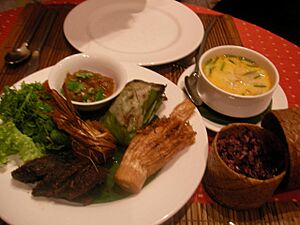

Sticky rice is a staple food. There are traditions and rituals associated with rice production in environments and among ethnic groups. For example, Khammu farmers in Luang Prabang plant the rice variety khao kam in quantities near the farm house in memory of dead parents, or at the edge of the rice field to indicate that parents are still alive.
Cinema
The first feature-length film made after the monarchy was abolished is Gun Voice from the Plain of Jars directed by Somchith Pholsena in 1983 and its release was prevented by a censorship board. A commercial feature-length film was Sabaidee Luang Prabang, made in 2008. The 2017 documentary feature film Blood Road was predominantly shot and produced in Laos with assistance from the Lao government. It was recognised with a News and Documentary Emmy Award in 2018.
Australian filmmaker Kim Mordount's first feature film was made in Laos and features a Laotian cast speaking their native language. Entitled The Rocket, the film appeared at the 2013 Melbourne International Film Festival and won 3 awards at the Berlin International Film Festival. Examples of Lao feature films that have received international recognition include Lao New Wave Cinema's At the Horizon, directed by Anysay Keola, which was screened at the OzAsia Film Festival, and Lao Art Media's Chanthaly (Lao: ຈັນທະລີ), directed by Mattie Do, which was screened at the 2013 Fantastic Fest. In September 2017, Laos submitted Dearest Sister (Lao: ນ້ອງຮັກ), Mattie Do's second feature film, to the 90th Academy Awards (or the Oscars) for consideration for Best Foreign Language Film, marking the country's first submission for the Oscars.
As of 2018, Laos has 3 theatres dedicated to showing films.
Festivals
There are some public holidays, festivities and ceremonies in Laos.
- Hmong New Year (Nopejao)
- Bun Pha Wet
- Magha Puja
- Chinese New Year
- Boun Khoun Khao
- Boun Pimai
- Boun Bang Fai (Rocket festival)
- Visakha Puja
- Pi Mai/Songkran (Lao New Year)
- Khao Phansaa
- Haw Khao Padap Din
- Awk Phansaa
- Bun Nam
- Lao National Day (2 December)
Sport
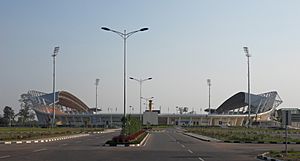
The martial art of muay Lao, the national sport, is a form of kickboxing similar to Thailand's muay Thai, Burmese Lethwei and Cambodian Pradal Serey.
See also
 In Spanish: Laos para niños
In Spanish: Laos para niños





